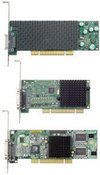Graphics cards target multi-headed thin clients, support Linux
Jun 20, 2006 — by LinuxDevices Staff — from the LinuxDevices Archive — 16 views Matrox Graphics is shipping a family of graphics cards aimed at multi-headed thin clients and network computers. The EpicA series dual- and quad-display graphics cards are supported by binary-only Linux drivers, but source may be available to thin-client builders, according to the company.
Matrox Graphics is shipping a family of graphics cards aimed at multi-headed thin clients and network computers. The EpicA series dual- and quad-display graphics cards are supported by binary-only Linux drivers, but source may be available to thin-client builders, according to the company.
(Click for larger view of Matrox EpicA TC4)
Multi-headed systems have become popular for graphics-intensive applications in which user interface components are easily compartmentalized, Matrox notes, citing CAD (computer-aided design) and GIS (geographic information systems) applications as examples. However, few if any network computers to date have supported multiple screens.



Typical usage examples
 LC4, LC2, & LC2-Lite (Click to enlarge) |
The EpicA family includes:
- TC4
- Four monitors
- 128MB of graphics memory
- WWWWXGA (6400 x 1200) resolution
- TC2
- Two monitors
- 64MB of graphics memory
- 4096 x 1536 resolution
- TC2-Lite
- Two monitors
- 32MB of graphics memory
- WWXGA (3200 x 1200) resolution
The EpicA cards come with foot-long adapter cables terminated by DVI connectors that, with user-supplied DVI cables, can be used to attach digital monitors. The cards come with DVI-to-VGA adapter cables, to attach analog monitors.
The passively cooled EpicA cards feature low power consumption, and are normal PCI cards that should work in most any PC or PCI-equiped thin client, Matrox says. The cards support Matrox's server-based software for managing multi-display configurations in remote sessions, according to the company. Additionally, under Linux, the cards can support Windows application hosting via the open source rdesktop package.
According to Serge Bohdjalian, of Matrox's marketing department, “The Linux display drivers for EpicA products are closed-source binaries, but source code may be made available to thin-client builders so that they can optimize and recompile it.”
Samuel Recine, Matrox's business development manager, stated, “EpicA series represents our continuing effort to bring reliable, high-quality, Matrox multi-display solutions to a wider variety of professional systems.”
Availability
Matrox says EpicA cards are available now, through its authorized reseller channel. Pricing was not disclosed.
This article was originally published on LinuxDevices.com and has been donated to the open source community by QuinStreet Inc. Please visit LinuxToday.com for up-to-date news and articles about Linux and open source.